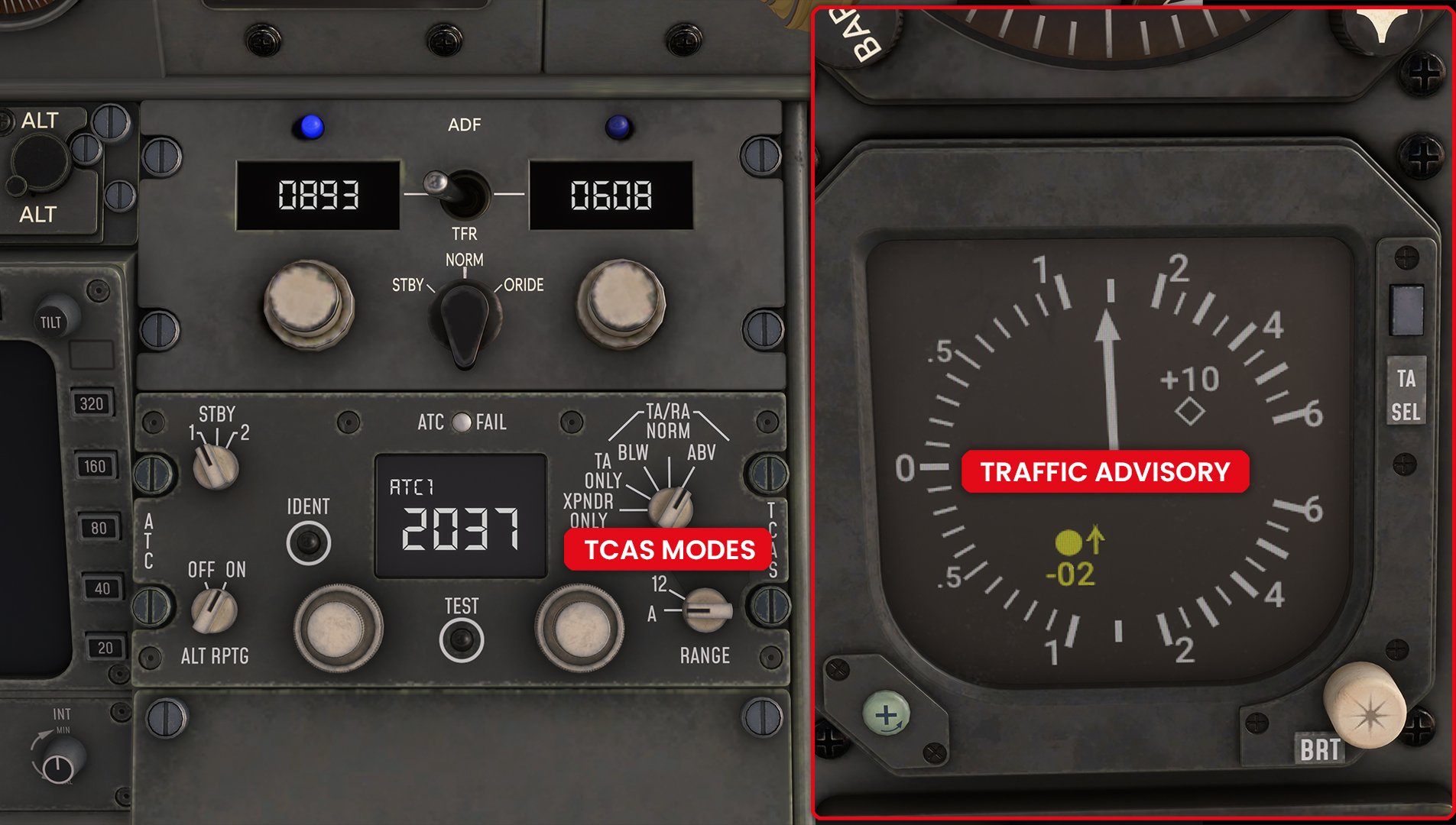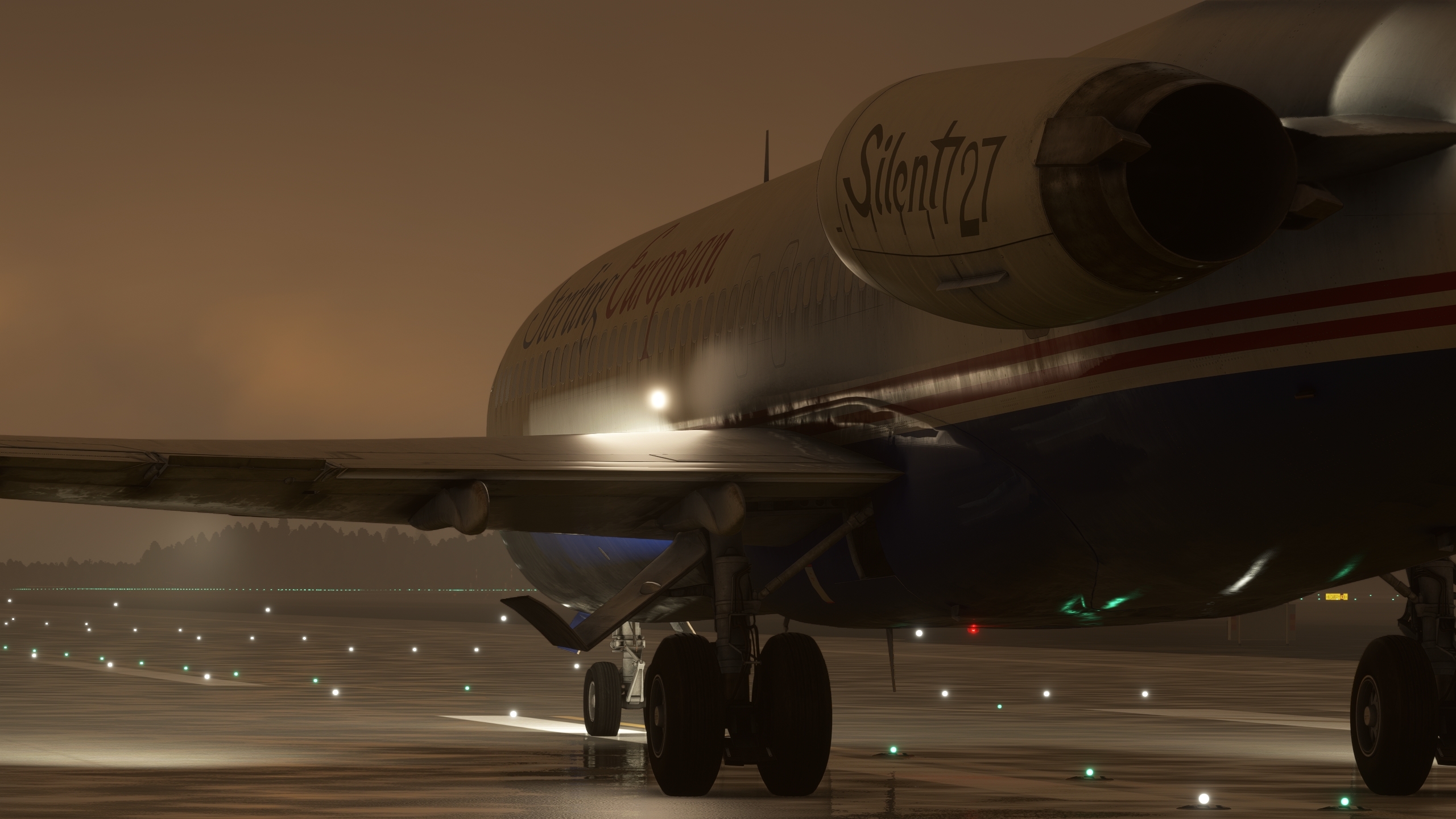Hello captains,
Today we’re showing you that our upcoming Super27 expansion isn’t just about good looks - it’s also packed with a ton of new tech under the hood. Enjoy!
TCAS

Auto Spoiler
If you’ve flown modern Boeing aircraft, you’ll know the spoiler arm mode. Some virtual airlines flight report validators nearly lose their minds when spoilers aren’t deployed on landing - automation has spoiled us, after all. Now, the 727 joins the club!

Dual DME
We didn’t forget about the old-school radio navigation fans. With now two DME receivers, you can fly proper coupled navigation. There’s something incredibly satisfying about arriving exactly where you planned without a moving map or any extra tools.
Let’s take a quick example with Carnival Air Lines, flying from Fort Lauderdale (KFLL) to Nassau (MYNN). After departing Runway 10R, we make a right turn to intercept the inbound radial 301 of the Bimini VOR, located about 50 nm away on the southern Bimini island in the Bahamas. Once we cross it, we continue outbound on radial 108.
The approach takes us straight onto the ILS 14 - we just need to know when we’ve reached the IAF MUNIE. And that’s exactly where cross-bearing comes in. We tune the second VOR2 receiver to the Nassau VOR, which sits right on the airport. When DME1 shows around 95 and DME2 reads 14, that’s our cue: we’ve nailed MUNIE and can turn onto the ILS.
Give it a try yourself - it’s a pretty cool feeling!

EFIS Suite
With the Super27 Expansion Pack, the 727 receives a major avionics upgrade, which can optionally be selected via the clipboard: the Rockwell Collins EFIS-86C. This modern Electronic Flight Instrument System replaces the classic ADI and HSI displays and, together with the APS-85 autopilot and the dual GNS-XLS flight management system, brings a whole new level of capability into the cockpit of this classic jet.
The Electronic Attitude Director Indicator (EADI) doesn’t just show the familiar attitude display – it also provides flight director commands, autopilot and mode annunciations, as well as deviations from VOR, LOC, LNAV, VNAV, or glideslope. On top of that, you get decision height indications and warnings, airspeed and Mach with trend vectors and speed bugs – essentially everything you need for precise approaches and confident flight guidance.
The second major display, the EHSI, combines traditional navigation information with a modern map-like view. You can choose between the full compass rose, the expanded sector view, or the sector with map mode, which adds waypoints, navaids, and your active route right on the screen. Alongside course deviations and bearing pointers, the EHSI gives you selectable ranges up to 600 NM, data such as wind, groundspeed, or time-to-go, and even waypoint or DME identifiers.
All of this is controlled via the Display Control Panel and the Course Heading Panel, which provide full access to course, heading, navigation sources, ranges, and additional navigation data. The result is that the 727 becomes fully LNAV and VNAV capable, making longer flights with FMS integration far more convenient.

Autopilot
Alongside the EFIS suite, the Super27 introduces the Collins APS-85 autopilot system (only in combination with EFIS and GNS-XLS), giving the 727 a truly modern flight control backbone. Mounted on the pedestal below the throttles, the autopilot panel provides levers for autopilot and yaw damper engagement, as well as the familiar pitch wheel and turn knob that allow you to “take command” of the system at any time.
The turn knob lets you directly control the aileron channel in roll hold mode, while the pitch wheel gives you immediate authority over the vertical profile, adjusting vertical speed, IAS, or Mach commands depending on the mode in use. Both controls provide a simple way to override or fine-tune the automation whenever needed.
Autopilot and yaw damper can be engaged separately, though the system ensures that if the autopilot is on, the yaw damper is also active. Mode selection happens on the glareshield panel, with lateral modes grouped to the left and vertical modes to the right. The autopilot always reverts to a safe basic mode - roll hold laterally, vertical speed vertically - whenever other modes release, after power interruptions, or following a go-around.
On the lateral side, the APS-85 covers everything from simple heading hold, through NAV tracking, to full approach capability down to CAT II minimums. Half-bank mode can be selected for smoother turns, and once an ILS approach is captured, the system arms the glideslope automatically.
Vertically, the system is just as capable. It can hold pitch attitude, maintain a selected vertical speed, or fly programmed climb and descent profiles. Altitude hold and altitude select functions provide precise level-offs, while VNAV allows the autopilot to follow vertical paths provided by the GNS-XLS FMS. In SPEED mode, the system switches seamlessly between IAS and Mach depending on altitude, and the go-around function instantly commands wings-level with a safe pitch-up when activated from the yoke.
The result is a robust, versatile autopilot that transforms the handling of the 727. Whether you want hands-off stability on cruise, precise captures on approach, or smooth VNAV integration with the FMS, the APS-85 brings modern reliability to the Super27 while preserving the aircraft’s classic character.

That’s it for today, but stay tuned. Very soon you’ll get to see the first previews in motion. Things are about to kick off 🎉



